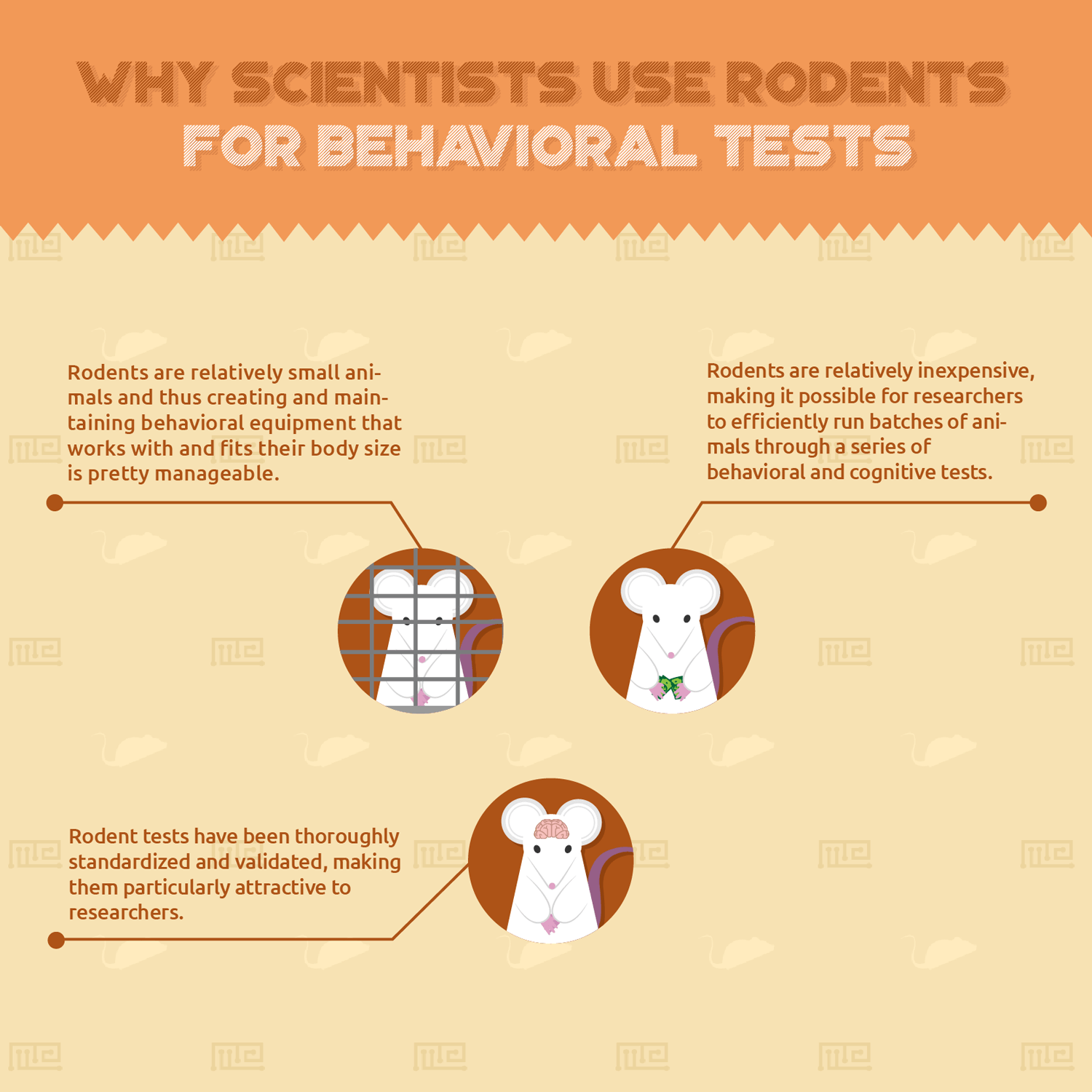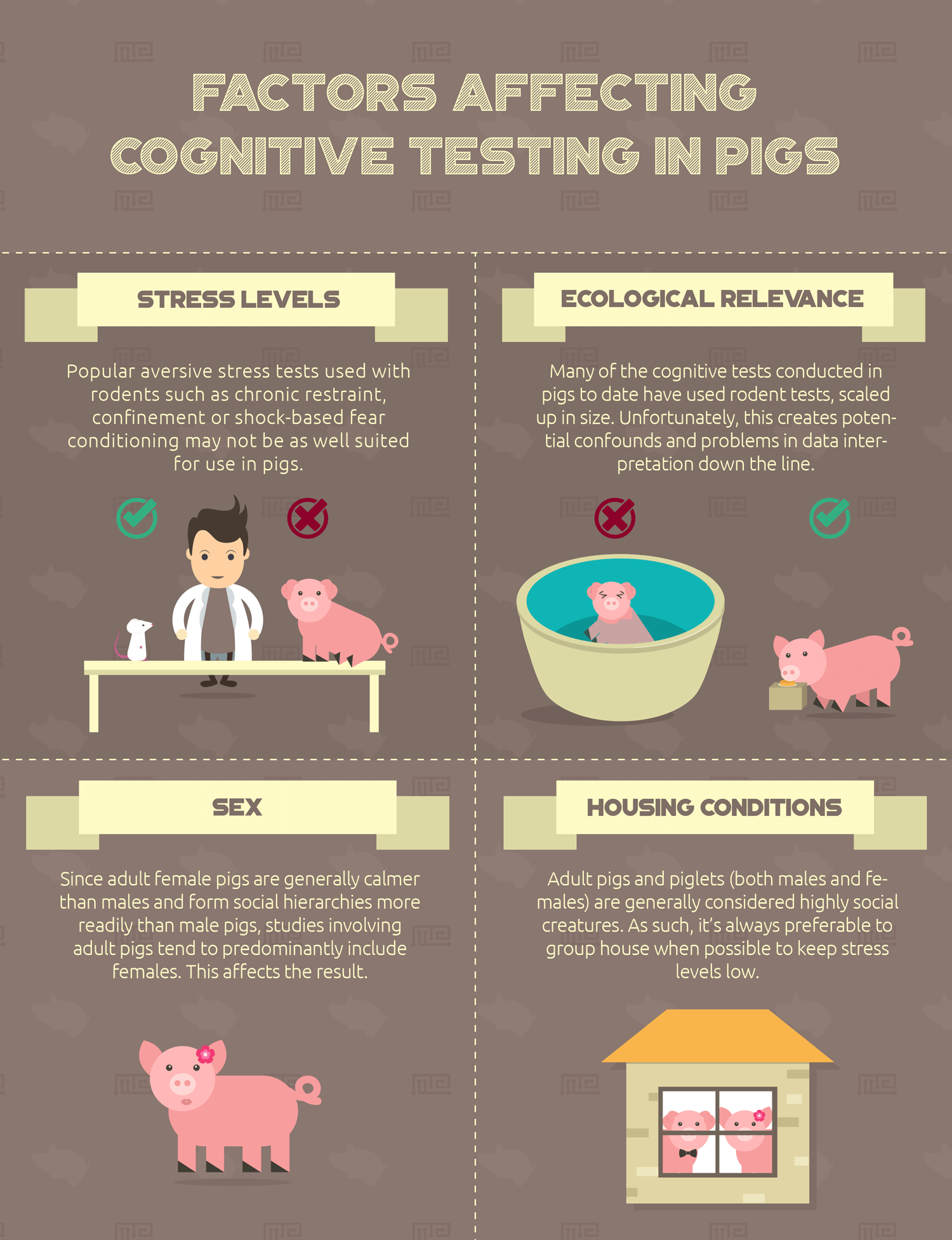A quick read of the most current neuroscience headlines may provide the impression that nearly all animal testing is performed in rodents. Whether it’s testing the latest drug, investigating learning mechanisms, or interrogating basic neural circuits, the rat and the mouse seem to be front and center of every study. There are a good number of reasons for this. First, rodent tests have been thoroughly standardized and validated, making them particularly attractive to researchers. Secondly, rodents are relatively inexpensive, making it possible for researchers to efficiently run batches of animals through a series of behavioral and cognitive tests. Last, but not least, they are relatively small animals and thus creating and maintaining behavioral equipment that works with and fits their body size is pretty manageable.
Despite the advantages rodent testing presents, preclinical testing with rodents has not always translated well to clinical research in humans. Indeed, the dissimilarities between rodents and humans are perhaps more numerous than are the similarities. The physiology, immune system and body mass of rodents are largely different from that of humans, and unless the preclinical rodent study is well designed and carefully accounts for these factors, translation to the clinical side is largely ineffective. These issues have resulted in a number of proposed solutions, including the choice of a different animal model. The mini pig or Sus scrofa has been proposed as a potential animal model that could effectively fill the gap between preclinical rodent research and human clinical trials. Unlike rodents, pigs have gyrencephalic brains and their physiology and immune system more closely resembles that of the human. The minipig also has a larger brain (up to 80g) compared to rodents, making it a more suitable animal model for
imaging studies. Why then, are there so few neuroscience studies involving pigs?
One of the most commonly cited reasons for this is the paucity of standardized and validated tasks. Indeed, most pig studies of cognition, learning, and memory have attempted to adapt the well-validated rodent tasks to the pig and this, unfortunately, has not always worked well. Furthermore, while the present discussion will focus mostly on mini pigs (specifically bred as small laboratory animals), research has also been done on other pig species, such as the domestic pig – and notable differences exist between the two species, though they have not yet been directly compared. Future research should bear this in mind when designing studies and most especially when comparing results across studies using different pig species.
Some Behavioral Tests used in Pigs
Morris Water Maze
In the rodent version of the Morris Water Maze task (designed to test spatial and reference memory), the rodent swims around in a large pool of opaque water and ultimately learns to use the spatial cues in the room to locate a hidden (underwater) escape platform. The piglet version of this task is essentially the same, but is literally scaled up in size. A large (3.6m diameter) inflatable swimming pool is filled with opaque water (50 cm deep) and the escape platform is likewise hidden from sight. Piglets are allowed to swim freely until they find the platform. Over a number of days, the animal learns the location of the platform and swims to it with a shorter latency, indicating the presence of a formed memory. While the piglets are capable of learning and completing this task, it should be noted that thus far, this task has been used in only one study (Siegford et al., 2008) and further validation is still needed. Furthermore, concerns about ecological validity (discussed in more detail below) should be carefully considered in this task.
Eight-Arm Radial Maze
To test working memory in rats, many researchers have traditionally relied on the eight-arm radial maze. In this task, the animal is placed in the center of the maze and the arms are baited with a food reward. The animal’s main task, then, is to remember what arm it has already visited so it does not go down that arm again. Variations of this task are then designed off of this basic principle. For example, animals can be trained to “win-shift” or “win-stay” on the maze, where the former requires the animal to choose previously visited arms and the latter requires the animal to choose previously unvisited arms. Previous studies have successfully demonstrated that pigs are capable of learning this task. Interestingly, pigs in this task have shown a general disposition to avoid previously visited arms. Because of this, it may appear that pigs more readily learn the “win-shift” task than the “win-stay” task, when in reality it may just be a predisposition for one behavior over the other. This particular critique remains unresolved, however, since the parameters on this maze have not yet been standardized for pigs. For example, some studies have even used this maze across various rooms in an attempt to scale up in size, which may introduce some potential confounds in interpretation. Thus, this particular task could benefit from further standardization.
Spontaneous Object Recognition Task
The spontaneous object recognition (SOR) task is analogous to the novel object recognition (NOR) task used with rodents. In essence, this task measures how much time an animal spends exploring a novel object compared to a familiar object. Typically, animals prefer novelty and thus, by quantifying exploration time of familiar versus novel objects, this test measures an animal’s memory for the familiar. Importantly, the delay interval between presentations of object pairs can affect the success of discrimination between the novel and the familiar object. One study by Kornum et al. (2007) tested a 10-minute, 1-hour and 24-hour delay period; using the 10-minute and 1-hour intervals, pigs were still able to discriminate between familiar and novel objects but by 24-hours, the exploration time between novel and familiar was not significantly different. Thus, future use of this task with pigs should bear this in mind when running the experiment. Additionally, it is important to check for potential object bias (i.e. an animal may have an innate preference for one object over another, regardless of familiarity).
Factors That Can Affect Cognitive Testing in Pigs
When it comes to pigs, there are numerous factors that can affect task performance. As such, researchers should take care to keep these factors in mind when designing learning and memory experiment with pigs. Some of these considerations are outlined below:
Stress Levels
Pigs are highly social creatures. Thus, popular aversive stress tests used with rodents such as chronic restraint, confinement or shock-based fear conditioning may not be as well suited for use in pigs. Indeed, researchers may find that their behavioral and physiological results are highly confounded by the levels of stress and fear that pigs exhibit during testing. This cautionary note stands especially in light of the well-document adverse effects of stress on memory and physiological function. Importantly, when pigs are stressed they will generally sound alarm calls (squeals, grunts or barks). While this can sometimes be minimized through habituation of the pigs to the experimental paradigm, it’s not always effective. Thus, researchers should always pay attention to the vocalizations that pigs make in the experiment[1] so as to
remain aware of possible confounds and[2] to potentially use this as a measure of fear and stress in the study, if applicable.
Ecological Relevance
Many of the cognitive tests conducted in pigs to date have used rodent tests, scaled up in size. Unfortunately, this creates potential confounds and problems in data interpretation down the line. For example, unlike rodents, pigs are not very good swimmers and it’s likely that simply scaling up the size of the swimming pool in the Morris water maze task is an insufficient modification. Indeed, in a study using a pig water maze, successful learning depended on the number of turns a piglet had to make, indicating that the physicality of this task is likely not ecologically suited for pigs. Similarly, in operant conditioning tasks that required lever pressing, pigs were able to press the lever but had a difficult time keeping the lever depressed. In contrast, in tasks where pigs were trained to press a button with their snouts (which bears some natural resemblance to a common pig behavior known as “rooting”), no physical difficulties were noted. These two examples alone highlight the need for ecologically valid testing methods.
Sex and Housing Conditions
Studies with piglets tend to include both sexes. In contrast, since adult female pigs are generally calmer than males and form social hierarchies more readily than male pigs, studies involving adult pigs tend to predominantly include females. Future studies should aim to balance the number of adult males and females used to ensure that behavioral results are not driven by sex differences. Ease of social hierarchies aside, adult pigs and piglets (both males and females) are generally considered highly social creatures. As such, it’s always preferable to group house when possible to keep stress levels low.
Outstanding Issues
The bottom line is: pigs are promising animal models for learning and memory tests. However, there are several outstanding issues that need to be addressed by researchers, including:
- The development of a validated habituation paradigm
- A characterization of behavioral differences between pig strains
- A systematic study of whether (and to what extent) time of day effects behavioral testing
- A systematic study of developmental differences (i.e. how do adults and piglets differ?)
- A careful study of sensory capacities (for example, their vision is not as great as their audition. It will be important to compare and contrast these prior to developing tests).
A validation of pig-specific behavioral tests (i.e. not just a “scaling up” of rodent tests)
Conclusion
Perhaps the most important consideration listed above is the need for well-standardized and well-validated pig-specific behavioral tests. At the very least, this will allow for more meaningful comparison of results across laboratories throughout the world. The development of well-validated tests will depend on some of the considerations listed prior (such as stress levels, housing conditions, sex differences and ecological validity). As basic behavioral pig tests are developed, it will be important to keep an eye toward the subtler behavioral differences that can be indexed by more sensitive behavioral assays. For example, it will be important to develop learning and memory tests with varying levels of difficulty and tests that capture more than one output measure (i.e. a combination of sensory, cognitive, motor, etc), so as to more thoroughly index the complex behavior of pigs, especially in response to an experimental manipulation.
Despite the amount of work still needed to validate and standardize pig behavioral testing, its success promises to bridge an important gap between rodent and non-human primate testing. As animals with a physiological and immunological system that closely resembles that of humans, they are well suited for translational research studies. This is especially true for brain imaging studies, since the pig brain is large enough for imaging and brain diseases can be more easily modeled here than in rodent brains. Indeed, aside from the potential benefit pigs could afford human clinical trials, a better understanding of cognitive functioning in pigs is important for improvements in animal welfare and farming practices. A careful characterization of their cognitive capacities and limitations will be beneficial to improving both animal and human welfare alike.
References
- Gieling ET, Nordquist RE, van der Staay FJ. 2011a. Assessing learning and memory in pigs. Anim Cogn. 14 (2), 151-173.
- Kornum BR, Knudsen GM. 2010. Cognitive testing of pigs (Sus scrofa) in translational biobehavioral research. Neuroscience and Biobehavioral Reviews. 35: 437-451.
- Kornum, B.R., Thygesen, K.S., Nielsen, T.R., Knudsen, G.M., Lind, N.M., 2007. The effect of the inter-phase delay interval in the spontaneous object recognition test for pigs. Behav. Brain Res. 181, 210–217.
- Siegford, J.M., Rucker, G., Zanella, A.J., 2008. Effects of pre-weaning exposure to a maze on stress responses in pigs at weaning and on subsequent performance in spatial and fear-related tests. Appl. Anim. Behav. Sci. 110, 189–202.


